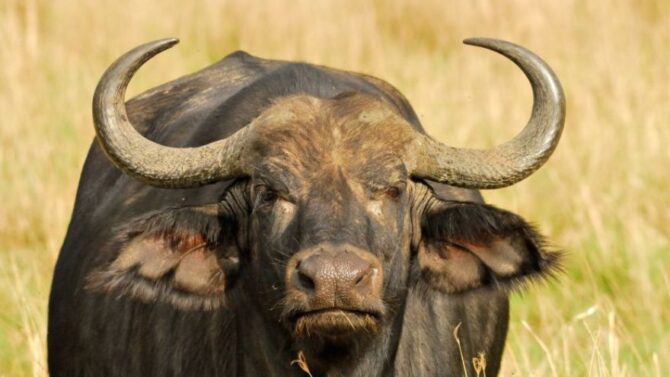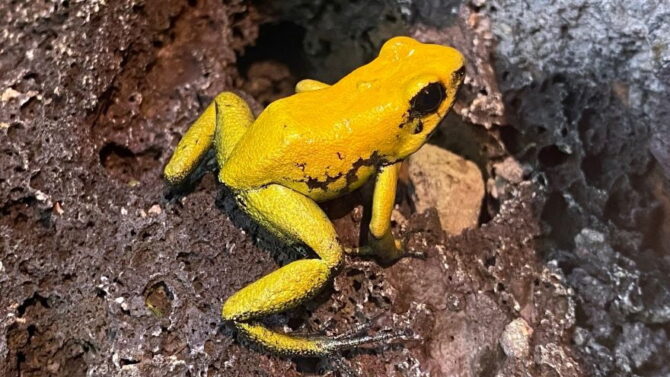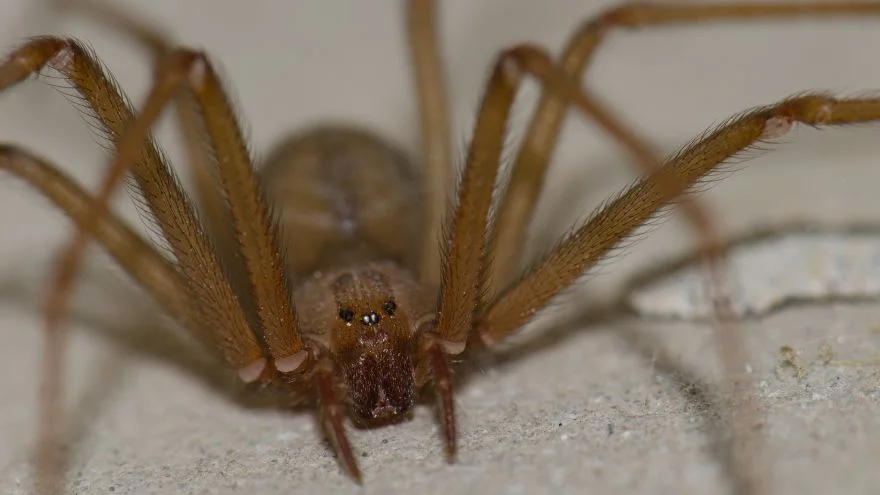South America is rich with a wide range of habitats that provide a home to various animal species. There is a high chance you will see many exciting, terrifying, and exotic animals if you plan to visit the tropical continent soon.
However, this article will give you insight into the wildlife in South America if you have no plans to travel through this magical continent or did not enjoy its diversity as you wanted.
South America proudly claims the Amazon biome, home to the world’s largest tropical rainforest and drained by one of the world’s greatest rivers.
Scientists have recognized about 3,000 fish, 427 mammals, 378 reptiles, 1,294 birds, 427 amphibians, and millions of insects in the Amazon biome, the world’s richest.1
The Jaguar ranks amongst South America’s top wildlife, while the notorious green anaconda and poison dart frog leads the army of the jungle’s deadliest animals. Please keep reading to see some of our favorite South American animals!
Wildlife in South America: Top Native Animals in South America
South America houses several species, ranging from wild cats to small mammals.
While all these animals contribute to wildlife diversity, some are more prominent than others, stealing the show at national parks and zoos or earning recognition as a country’s national animal. Here are some of South America’s top wildlife.
Jaguar

Scientific Name: Panthera onca
Wild cats will rank anywhere as one of the top wildlife, and the Jaguar is no exception in South America. Other members of the Panthera genus reside in Africa and Asia, but the Jaguar is the only member native to the Americas.
While the Jaguar somewhat looks like the leopard, it has a distinctive coat feature, with pale yellow to tan-colored fur and many spots that transition to rosettes on the sides.
Jaguars also bite through the skull of their mammalian prey, an unusual killing method as other species in its genus prefer attacking prey in the neck.
The Jaguar’s killing method might be gruesome, but it remains a keystone species, stabilizing ecosystems and regulating prey populations.
Jaguars occupy inland wetlands and low-lying tropical habitats near water bodies and retain a wide range from Mexico through Central America to South America despite losing about half of their historic range.
Sloth
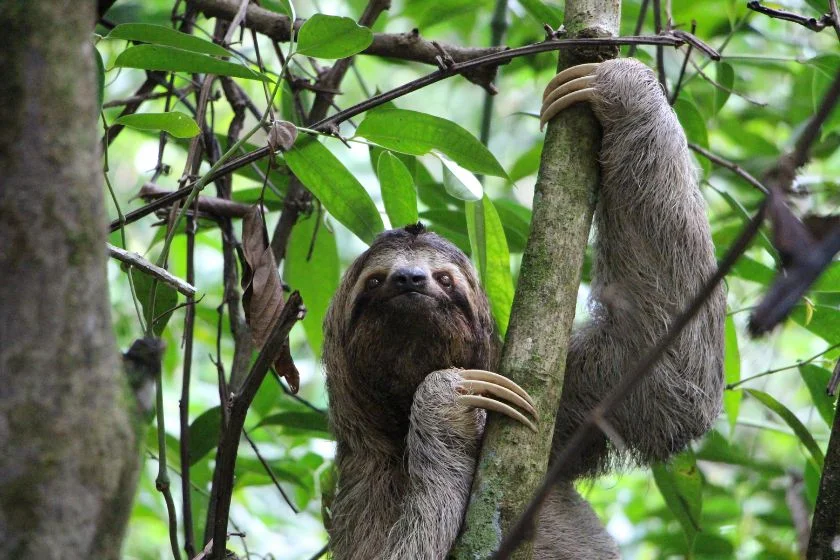
Scientific Name: Folivora
Slowness is a reputation that precedes sloths, and the three-toed sloth would be an all-time defensive champion if slowness were a competition.
These animals are largely arboreal, spending most of their lives hanging upside down in the trees of South America’s tropical rainforests.
The tropics would remain an everlasting habitat for sloths due to their lower metabolism, as it provides them with the best weather for digestion and thermoregulation.
Brazilian Guinea Pig
Scientific Name: Cavia aperea
The Brazilian guinea pig is nothing like a pig nor a species introduced from Guinea, but a rodent closely related to the domestic guinea pig (Cavia porcellus) and endemic to South America.
These rodents are usually around eleven inches, characterized by dark olive-brown coats fused with brown and black fur and pale or yellowish-grey underparts.
Brazilian guinea pigs inhabit South America’s forests, grasslands, deserts, and savannas, where they eat grasses and other herbs. Argentina, Bolivia, Brazil, and Colombia have stable Brazilian guinea pig populations.
Vicuna
Scientific Name: Lama vicugna
Llamas are domestic camelids popular amongst South Americans, but the Vicuna is its wild relative, occupying the Andes in western Bolivia, northwestern Argentina, southern Peru, and northern Chile.
While the Vicuna might not rank amongst the world’s most popular animals, it is highly regarded among Peruvians, appearing on the country’s coat of arms and earning a wide-ranging status as its national animal.
Vicunas love the mountains and enjoy cold-dry weather. However, they sought after vegetative territories and stretches of bare ground with semi-arid rolling grasslands, plains, and marshes.
Tamarins
Scientific Name: Saguinus
Tamarin is a genus of twenty-two small New World monkey species around a squirrel’s size. These species vary significantly in appearance, from nearly all black to species with a mixture of black, brown, and white fur.
However, many species have common features of mustache-like facial hairs, like in the bearded emperor tamarin. Tamarins inhabit South America’s tropical rainforests and are common in the Guianas, Amazon Basin, and northwestern Colombia.
While they bear the same name as the lion tamarins, a different genus of four species, they are distantly related.
Capybara
Scientific Name: Hydrochoerus hydrochaeris
The capybara is the world’s largest extant rodent; little wonder some call it the greater capybara, measuring over four feet in length, almost two feet in height, and about a hundred pounds in weight. Capybaras live in the Amazon rainforest and flooded savannahs, primarily feeding on grasses and aquatic plants.
Therefore, one can find these rodents in many South American countries, including Brazil, Columbia, Uruguay, Venezuela, and northeast Argentina.
These countries’ occupants are no strangers to the capybara, hunting the rodent for its meat, hide, and grease from its thick, fatty skin. Fortunately, the capybara has a stable population, listed as “Least Concern” by the IUCN.2
Crested Quetzal
Scientific Name: Pharomachrus antisianus
The crested quetzal is a species of quetzal bird endemic to South America. Quetzals are colorful birds, and the created quetzal is no exception.
However, male crested quetzals differ from other species, including the popular resplendent quetzal (Guatemala’s national bird), by a short orange crest above their short bill.
The crested quetzal bird feels at home in tropical and subtropical moist montane forests in Colombia, Peru, Bolivia, Ecuador, and Venezuela.
The Most Dangerous Animals in South America
South America’s diverse wildlife contains some animals notorious for aggressiveness and territorial traits. The Jaguar ranks among South America’s deadliest animals.
Still, there are other dangerous animals you do not want to face off with. Here are some of South America’s most dangerous animals.
Green Anaconda
Scientific Name: Eunectes murinus
The green anaconda is famed for its size, being the heaviest and one of the longest of all extant snake species.
It is a boa species endemic to South America, inhabiting Bolivia, Brazil, Colombia, Ecuador, Venezuela, the Guianas, and Peru’s tropical rainforests, swamps, slow-moving streams, and marshes.
While it is a non-venomous snake, mature anacondas average sixteen feet, five inches, and weigh up to 154 pounds, a size almost impossible to contend with.
Green anacondas are constrictors, experts in ambush attacks, and excellent swimmers. Their abilities help them to overpower many animals, including deer and caimans.
Therefore, they rank amongst the most feared wild animals capable of consuming a human, even though such occurrences are extremely rare.
Poison Dart Frogs

Scientific Name: Dendrobatidae
Poison Dart Frogs majestically clothe themselves in some of the world’s brightest and the most brilliant colors. Their habitat, ranging from Costa Rica’s and Colombia’s to Brazil’s tropical forests, determines their colors, yellow, red, gold, blue, green, or black.
These elegant colors and hues are an anti-predator modification to ward off potential predators, a ploy dubbed “aposematic coloration.” Still, they are equipped with lethal venom as a defensive mechanism.
While poison dart frogs may not bite humans, touching or consuming them can be ghastly or fatal; the poison in their skin can result in swelling, nausea, or paralysis.
For instance, the golden poison dart frog, measuring two inches, has enough venom to slay ten adult humans.
Fer-de-lance
Scientific Name: Bothrops asper
The Fer-de-lanceis a pit viper species in Colombia, Ecuador, Venezuela, and Trinidad. However, populations slither across Northwest Mexico and Central America.
The Fer-de-lance can grow over eight feet, weighing thirteen pounds. While its french name is enough to deter its popularity, a fearsome reputation precedes it.
This pit viper ranks amongst the world’s most dangerous snakes and is arguably South America’s most dangerous due to its defensive temperament, fangs, venom yield, and closeness to human residence.
The Fer-de-lance is one of Colombia’s most dangerous snakes, causing the most snake bite incidents (fifty to eighty percent).3
Victims suffer pain, swelling, bruising, numbness, blisters, nausea, headache, mild fever, vomiting, gastrointestinal bleeding, bleeding from the nose and gums, low blood pressure, impaired consciousness, and tenderness of the spleen.
Local necrosis leading to gangrene may occur in untreated cases, while intracranial hemorrhage, acute kidney injury, and hemorrhagic shock may result in fatality in extreme cases.
Bullet Ant
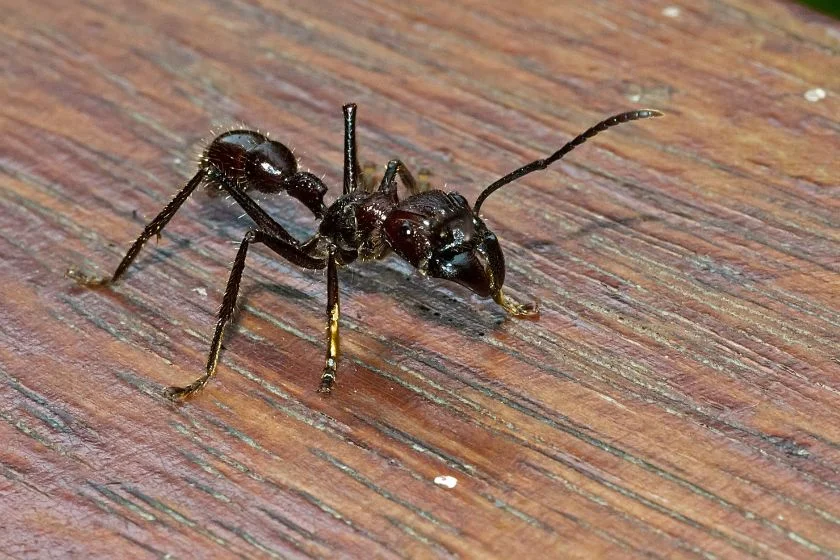
Scientific Name: Paraponera clavata
Since no one wants a bullet in their body, it is wise not to toil with the bullet ant. The insect, endemic to Central and South America’s humid lowland rainforests, has one of the most painful stings of any insect, accompanied by a neurotoxin.
The bullet ant’s victims suffer an intense and lasting burning sensation, temporary paralysis, and shaking in the poisoned area. Fortunately, the venom does not spread to the brain, heart, or other crucial organs or tissues.
Bullet ants do not attack without cause but waste no time defending their nests, aggressively reacting to threats from an unwelcome bullet ant or another species.
Brazil, Bolivia, Colombia, Ecuador, Peru, and Venezuela are South American countries that house the bullet ant.
Black Caiman
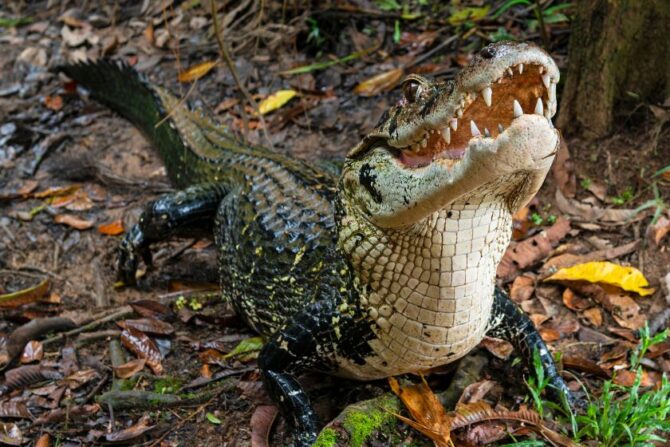
Scientific Name: Melanosuchus niger
No other species dare threaten the black caiman as it is the Amazon River basin’s largest predator, with males growing over thirteen feet long.
There are misconceptions about the black caiman being a crocodile, but it is a large, dark-scaled alligator that could be brown, tan, mottled gray, or olive. While black caimans do not primarily attack humans, they lack the fear instinct in prey species.
Therefore, they might mistake a human for prey, and the encounter could be dangerous.
Kissing Bugs
Scientific Name: Triatominae
Most countries in South America have a stable population of kissing bugs hiding in wall and roof crevices.
Kissing bugs are not romantic or friendly but are ranked amongst South America’s deadliest wildlife because of their parasitic feeding traits from humans’ mouths.
These bugs also feed on blood from people and other vertebrates, transmitting a parasite that leads to a potentially serious disease called Chagas.4
Endemic South American Animals
Some species exist everywhere, while others are ecologically distributed in specific locations. Several animal species live in South America, but the following are endemic to the continent.
Giant Anteater
Scientific Name: Myrmecophaga tridactyla
The giant anteater is one of four anteater species, popular for hunting ants and termites. The giant anteater is characterized by size, over seven feet, one inch long, and weight at over 110 pounds.
Its long foreclaws, bushy tail, and uniquely colored pelage also differentiate it from other members of its subfamily.
Like other members of its suborder, the giant anteater feeds on ants with body modifications, including an elongated muzzle, tubular snout, and tongue reaching eighteen inches to support its feeding.
Giant anteaters are endemic to South America, inhabiting many habitats, including grasslands, wetlands, and rainforests.
Mountain Tapir
Scientific Name: Tapirus pinchaque
The pig-looking herbivores called tapirs inhabit South America’s jungle and forest regions. However, the tapir is a group of four widely recognized species, and the mountain tapir is one of them, endemic to South America.
The mountain tapir differs from other species by its thick woolly coat and white lips. It occupies the cloud forests and alpine tundra ecosystems of the Andes Mountain Range in Colombia, Ecuador, and northern Peru.
Brown Spider Monkey
Scientific Name: Ateles hybridus
The brown spider monkey, one of the world’s critically endangered species, is endemic to South America, occupying the forests of northwestern Venezuela and northern Colombia.
It occurs as one of the most threatened primates, but South Americans feel proud to have a few individuals foraging in their undisturbed, primary lowland forest.
While monkeys are excellent climbers, brown spider monkeys are exceptional thanks to their long and thin limbs with longer forelimbs than hind limbs.
They have a distinctive thirty-inch long, flexible, thin, and prehensile tail that occasionally acts like a fifth limb to help them to rank among the world’s most skillful tree climbers.
Armadillo
Scientific Name: Dasypodidae
Armadillos, brown armored mammals with strong, curved claws and simple peglike teeth, are endemic to Central and South America, where they inhabit semi-deserts, grasslands, and rainforests in Paraguay, Uruguay, Brazil, and Argentina.
There are twenty-one extant armadillo species, all characterized by a leathery armor shell and distinguished by the number of bands on their armor.
The seven-banded armadillo (Dasypus septemcinctus), with seven bands on its armor, is common in Argentina, Bolivia, Brazil, and Paraguay; the nine-banded long-nosed armadillo occupies northern Argentina and Uruguay.
Endangered Animals In South America
Growth and increase in human population result in land clearance for agriculture. Still, climate change has taken its toll on South America’s species.
Many species in the continent are currently suffering from a population decline and are endangered due to habitat loss, poaching, and other unfortunate incidents. The following species rank among the continent’s most endangered species.
Orinoco Crocodile
Scientific Name: Crocodylus intermedius
Conservation Status: Critically Endangered
As its name suggests, the Orinoco crocodile occupies South America’s Orinoco River Basin, where it inhabits the Llanos Savannah.
Floods affecting the area during each rainy season create transient seasonal rivers that the crocodiles enjoy.
While one can find the Orinoco crocodile in Colombia and Venezuela, it is a critically endangered species that suffered extensive hunting for its skin in the 19th and 20th centuries.
Lemur Leaf Frog
Scientific Name: Hylomantis lemur
Conservation Status: Critically Endangered
The lemur leaf frog may switch from its natural green hue to another shade depending on whether it is active or asleep.
The frog’s distribution is patchy in Costa Rica, Panama, and northern Colombia, as it is currently an endangered species, according to the IUCN.
They used to cover a sizable portion of Costa Rica but have been losing ground recently, partly because of deforestation.
The Lemur leaf frog inhabits undisturbed humid rainforest habitats in montane and descending lowland forests, spending nearly their whole lives in trees, plants’ branches, and leaves.
Giant Otter
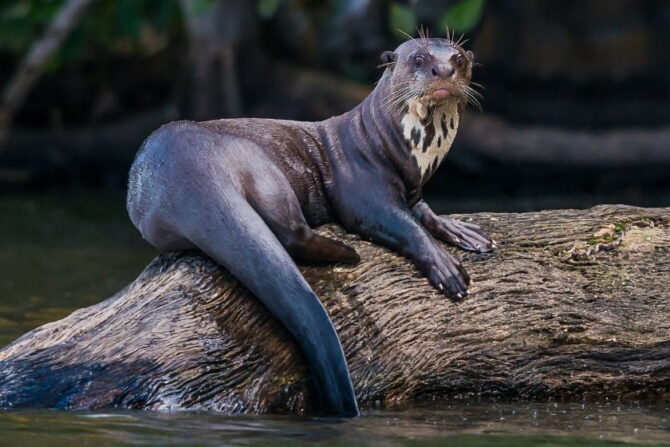
Scientific Name: Pteronura brasiliensis
Conservation Status: Endangered (Population decreasing)
The giant otter is endemic to South America, where they occupy the Orinoco, Amazon, and La Plata river systems in northern South America. A higher percentage of the giant otter’s population lives in swamps, marshes, lakes, and slow-moving streams and rivers.
They also inhabit flooded woodlands since these locations have a significant number of prey in the shallow waters; they also favor banks that do not flood with a lot of natural flora that makes it easy for them to hunt.
The giant otter range consists of southern Brazil, Paraguay, Uruguay, and northeastern Argentina. However, it is rare throughout its range, except in protected areas.
Black Squirrel Monkey
Scientific Name: Saimiri boliviensis
Conservation Status: Vulnerable
The tropical rainforests of South America are home to a unique type of monkey called the black squirrel monkey. Only a small portion of the Amazonian region in northern Brazil is home to these species.
Although they can survive in various forest habitats, they are most often found moving and foraging in the middle and lower strata of the forest canopy, including river edges, seasonal swamps, and secondary forests.
Pink Amazon Dolphin
Scientific Name: Inia geoffrensis
Conservation Status: Endangered
That’s right; pink Amazon dolphins are pink. The pink Amazon dolphin is a native of South America in the continent’s river systems. It mainly inhabits slow-moving rivers and streams in the Orinoco and Amazon drainage basins.
One can find them, among other places, in Bolivia, Ecuador, Colombia, and Peru. The pink dolphin leaves the flooded rivers during the rainy season as the water levels rise. Sadly, the pink Amazon dolphin is one of South America’s endangered species, according to the IUCN.
Reasons for population decline include human activities as fishers compete with the dolphins for the same fish species and killing the dolphins deliberately or unintentionally.
Birds in South America
There’s more to admire in the South American skies than Toucans and condors. Several colorful and majestic birds soar the skies, and South America is home to over three thousand bird species, with Colombia alone recording 1,863 species.5
Here are some South American birds.
Andean Condor
Scientific Name: Vultur gryphus
This specie of vulture is the National bird of several South American countries. As its name suggests, it traverses the Andes’ mountains and valleys. It extends all the way south to Tierra del Fuego, from Colombia and western Venezuela.
Andean condors are most frequently observed in Argentina, Chile, and Peru. The males can be different from the females using the comb which sits atop their heads. Their diet consists of dead animals, just like other vultures.
Greater Rhea
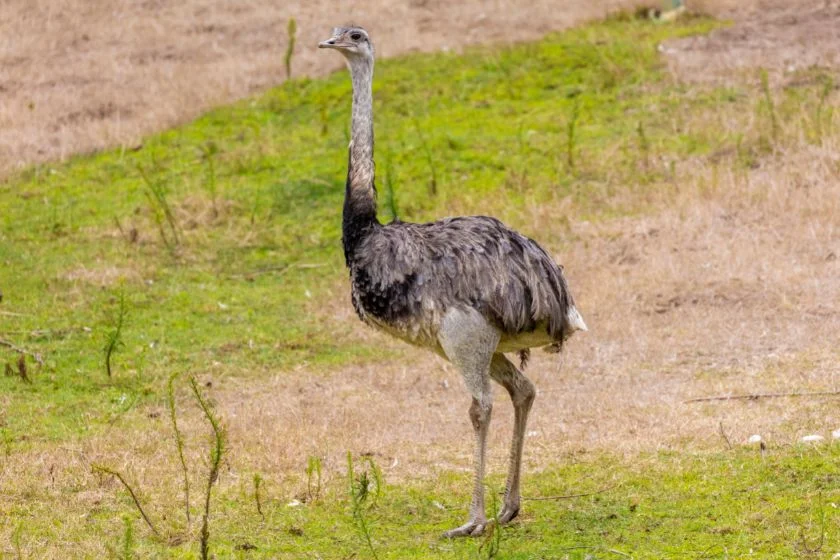
Scientific Name: Rhea americana
This bird bears a striking resemblance to the ostrich; it is a flightless bird native to South America.
The Greater rhea inhabits grasslands and semi-arid scrubland in southeastern South America, including Brazil, Bolivia, Uruguay, Paraguay, and Argentina.
Rheas remain close to lakes, marshes, and rivers during the breeding season. Most of South America’s highland and lowland plains contain them.
Waved Albatross
Scientific Name: Phoebastria irrorata
This bird has a brown body with a head and neck that are white and mixed in yellow. Its bill is quite lengthy and yellow. They inhabit the Galapagos Islands of Espanola.
One can also spot them breezing over coastal waters across Chile, Colombia, Peru, and Ecuador when searching widely for food.
Fish, squid, and crustaceans are the Waved Albatross’ main dietary sources. However, they have also been seen to scavenge for alternative food sources.
Toco Toucan
Scientific Name: Ramphastos toco
The toco toucan puts its bill into use as it uses it to pick fruit off trees. With this bird comes one of the longest bills in the world, and a very colorful one at that.
This bird is endemic to South America, as a large population of them can be seen in southern Brazil and northern Argentina; however, one can spot them in some areas of the Amazon jungle, right up to the great Amazon river.
They can be seen inhabiting various environments, such as shrubland, savannas, and tropical forests.
Harpy Eagle
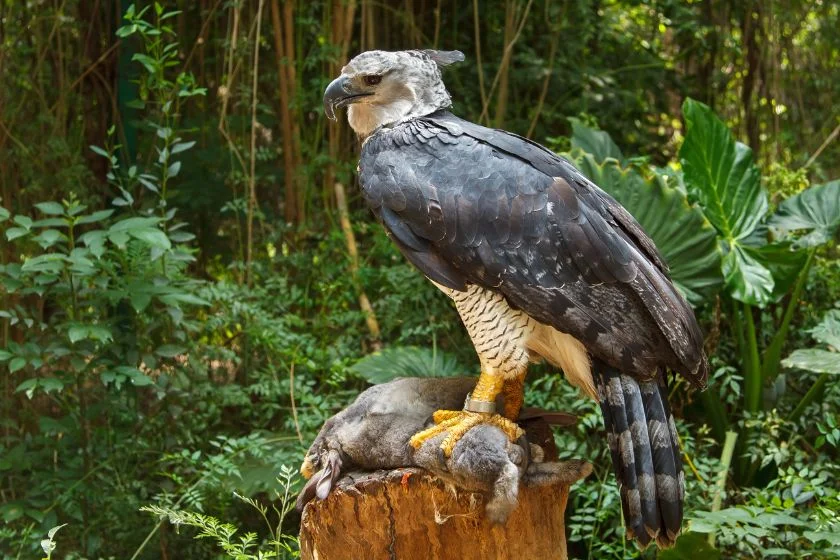
Scientific Name: Harpia harpyja
The harpy eagle is revered as the most powerful predatory bird; harpy eagles can be found in South America, all the way down to Argentina.
Harpy Eagles are mainly found in the Amazon and protected parts of Brazil’s Mata Atlântica jungle, but they are also occasionally seen in the Cerrado and Pantanal ecosystems.
Neotropical rainforests are the habitat of the Harpy Eagle. It resides at low altitudes where it may catch animals and build eggs in big trees.
Hyacinth Macaw
Scientific Name: Anodorhynchus hyacinthinus
The hyacinth macaw is the largest parrot species. Three different populations of the hyacinth macaw residential in northeastern Paraguay, eastern Bolivia, and southern Brazil.
The hyacinth macaw can be found mostly in palm swamps, riverfront tropical rainforests, and scrublands on the margins of the rainforest. Though its wide distribution also includes grasslands and sparsely forested areas. It is an endangered species.
Red-legged Cormorant
Scientific Name: Phalacrocorax gaimardi
The Red-legged Cormorant is found along South America’s Pacific coast from the equator south past Chiloe in Chile and southern Argentina.
It truly owns a pair of red feet, with the wings of the red-legged cormorants being grey with silver scales on them; it also has wide white spots on the sides of its neck.
More than 70% of the world’s breeding population, or less than 15,000 individuals, are thought to reside in Chile, with the northern and central regions of Chile having lone pairs or little colonies of this bird.6
Magellanic Woodpecker
Scientific Name: Campephilus magellanicus
The Magellanic woodpecker is an enormous bird in southern Chile and southwest Argentina. This bird spots a bright red crest (male) or a black crest (female).
They live in temperate woods on both sides of the southern Andes, with their distribution extending from Chile to Argentina.
Their diet includes small insects and vertebrates. This bird is endemic to South America and is known to inhabit the Nothofagus forest.
Fish in South America
South America holds the world’s largest river basin, the Amazon, covering over two million square kilometers, and inside are thousands of fish species.
The Caribbean Sea, Atlantic, and Pacific oceans surround the continent, providing shelter and other necessities to a host of marine fishes. The following are some notable fish species in South America.
Paiche
Scientific Name: Arapaima gigas
The Paiche, the mystic king of the Amazon, is native to the Amazon and Essequibo basin of South America. These species have sleek, scaly bodies that are black with a white center, tapering, coppery-green heads, and raised jaws.
The paiche lives in clean and clear water and inhabits the rainforest’s wetlands, particularly in the Brazilian and Peruvian regions.
Piranha
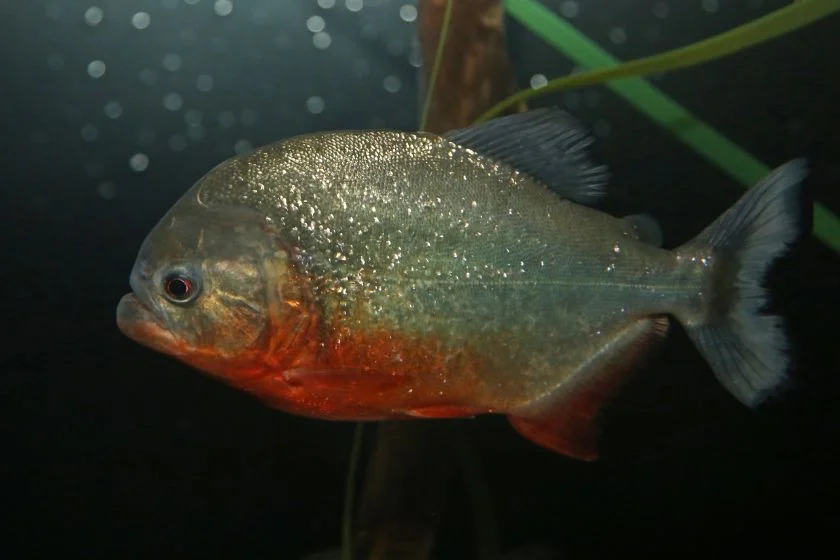
Scientific Name: Pygocentrus
South America’s central and southern river systems are home to piranhas, inhabiting tropical rivers, and are frequently seen in muddy waters.
Guyana’s Essequibo, other coastal rivers in Venezuela and Argentina, and the Amazon house the piranha.
The piranha’s lower jaws extend past its upper jaws and are short and strong; therefore, the fish can bite and tear into its prey’s flesh because both jaws have razor-sharp triangular teeth.
Electric Eel
Scientific Name: Electrophorus electricus
The electric eel can generate 860 volts, seven times the voltage that emanates from a US power outlet. This species is known to be a carnivore. The electric eel prefers gloomy pools as freshwater is its natural home.
This fish lives in secluded locations where there is little dissolved oxygen. Although they mostly inhabit the mid and lower Amazon and Orinoco river basins in Brazil, Guyana, Suriname, and French Guiana.
Gamitana
Scientific Name: Colossoma macropomum
The Amazon and Orinoco basins are home to the Tambaqui, which is endemic to South America.
Some people call the gamitana the Tambaqui; they resemble the piranha in shape, with a plate-like form, huge eyes, and a slightly arched back laterally compressed.
They are a solitary fish species, and adults remain in the inundated forests, grazing on nuts, fruit, grains, insects, snails, and dead plants during the rainy season. One can find the gamitana in Bolivia, Brazil, Colombia, and Ecuador.
Tucunaré Peacock Bass
Scientific Name: Cichla ocellaris
These beautiful fishes are nocturnal predators indigenous to tropical South America’s Amazon, Orinoco basins, and the Guiana rivers.
Tucunarés live in clean lakes, ponds, and waters and only move when they search for food in Brazil, Ecuador, and Peru.
Bigeye Tuna
Scientific Name: Thunnus obesus
This bigeye tuna spots a dark metallic blue on its backside. The dorsal and anal fins are yellow, the undersides are white, and the sides have iridescent blue lateral lines.
It is a diurnal species, meaning it can be spotted at night at the surface and during the day in deeper water.
Bigeye tuna exist in tropical or subtropical marine waters, where they may reproduce and eat; warm waters are preferred. The western Atlantic waters in Brazil host the bigeye tuna in South America.
Bignose Fanskate
Scientific Name: Sympterygia acuta
The bignose fanskate inhabits the waters of Rio de Janeiro, Brazil, to Bahia Blanca, Buenos Aires, Argentina, in the Southwest Atlantic, present in wide and shallow waters.
The fish consumes various prey, with teleosts, decapods, cetaceans, and isopods being the most significant.
Bull Shark

Scientific Name: Carcharhinus leucas
The bull shark is revered for its aggressiveness, adaptiveness, preference for shallow coastal waters, and migration ability. The shark can survive in shallow brackish and freshwater systems.
The bull shark inhabits these waters worldwide; in South America, one can find the bull shark in southern Brazil, occupying the Atlantic Ocean, and Ecuador, living in the Pacific Ocean.
Snakes in South America
Many venomous and non-venomous snake species call South America home, including some of the world’s largest, heaviest, and longest snakes. Here are some of them.
South American Rattlesnake
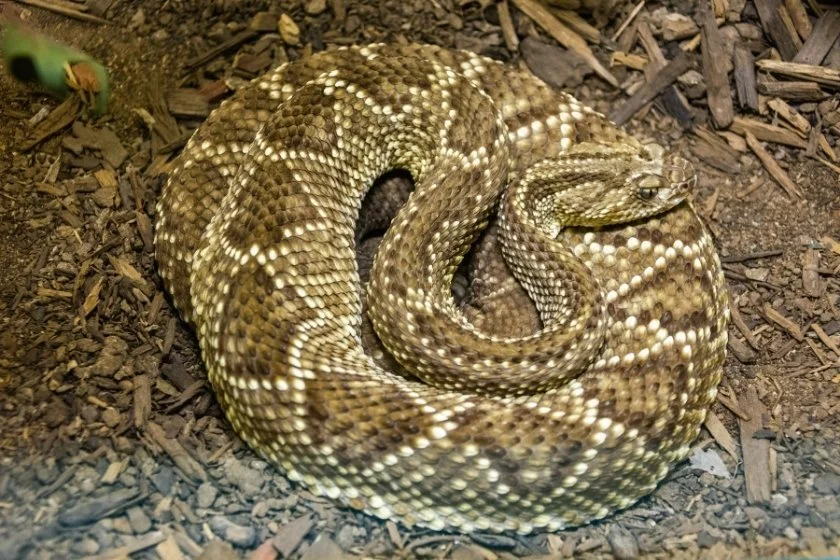
Scientific Name: Crotalus durissus
One of the most venomous snakes in America is the RattleSnake. This rattlesnake species is endemic to South America and has the strongest venom of all rattlesnake species, which is known to impair vision and result in permanent blindness.
South America has its variety of rattlesnakes known as South America rattlesnakes. It can be found in Guyana, Mexico, Venezuela, Columbia, Bolivia, Paraguay, Argentina, and Brazil.
Their habitat includes areas with open vegetation, such as savannahs, shrublands, and grasslands that are tropical, subtropical, and temperate.
South American Bushmaster
Scientific Name: Lachesis muta
The pit viper known as the bushmaster hunts at night. The woods of northwestern South America, particularly those in Colombia, Venezuela, Brazil, and Peru, are home to the bushmaster.
These snakes can be found in cleared areas, nearby farmland, and rainforests. The bushmaster also contains one of the world’s most lethal venoms; even with treatment, the risk of dying from a bushmaster’s venom is significant.
Two-striped Forest Pitviper
Scientific Name: Bothriopsis bilineata
It is a poisonous pit viper in South America’s Amazon region. It is prevalent around water, especially in lowland rainforests, shrubs, palms, and trees.
It is mostly associated with primary forests but has also been discovered in older secondary forests close to primary forests. Its venom can result in bleeding, severe kidney damage, edema, and excruciating agony.
Eyelash viper
Scientific Name: Bothriechis schlegelii
The eyelash viper enjoys residing in trees (Arboreal). It is native to South America and extends well into southern Mexico and Ecuador’s Peruvian lowlands.
In addition to tropical rainforests, wooded clouds, and dense sea-level forests, they can also be found in lowlands and foothills with streamlined vegetation. They prefer a humid, tropical climate and are best suited to lower elevations.
Emerald Tree Boa
Scientific Name: Corallus caninus
The emerald tree boa is one of South America’s non-venomous snake species; however, it has highly developed front teeth proportionately larger than other non-venomous snakes.
The emerald tree boa inhabits lowland tropical rainforests in the Amazon and Guiana biomes, slithering across Brazil, northern Colombia, Suriname, and Venezuela.
Emerald tree boas have a beautiful, distinctive emerald green ground color with irregular white zigzag stripes or ‘lightning bolts’ down the back and a yellow belly. In contrast, due to ontogenetic coloration, juvenile emerald tree boas are light or dark orange or brick-red before turning emerald green.
These snakes are constrictors, primarily eating small mammals, while small birds, lizards, and frogs also make the menu.
Dipsas
Scientific Name: Dipsas
Dipsas is a common name for snail-eating snakes found in the Americas. The genus comprises slender, small to medium-sized species, often about two feet long.
While coloration may vary according to species, these snakes are often black or brown, with alternating rings or bands separated by white.
The graceful snail-eater (Dipsas gracilis) inhabits northwestern Ecuador, Peru, and Colombia, and the Catesby’s snail-eater (Dipsas catesbyi) is endemic to northern South America.
There are thirty distinct species, some inhabiting South America, while others occupy North America, particularly southern Mexico. Dipsas are largely arboreal snakes, with snails and slugs comprising their primary diet.
Places to Watch Wildlife in South America
The Amazon biome, Andes mountains, grasslands, lowlands, wetlands, rivers, and other habitats house wild animals. However, walking into these areas might not be the safest option.
Still, one can view wildlife in their natural habitats, and below are some incredible locations to check out.
- Iguazu National Park, Argentina
- Nahuel Huapi National Park, Argentina
- Tierra del Fuego National Park, Argentina
- Amboró National Park, Bolivia
- Chapada Diamantina National Park, Brazil
- Lençóis Maranhenses National Park, Brazil
- Pantanal Matogrossense National Park, Brazil
- Vicente Perez Rosales National Park, Chile
- Lauca National Park, Chile
- Torres del Paine National Park, Chile
- Tayrona National Park, Colombia
- Cotopaxi National Park, Ecuador
- Galapagos National Park, Ecuador
- Kaieteur National Park, Guyana
- Manu National Park, Peru
- Canaima National Park, Venezuela
- Los Roques National Park, Venezuela
Frequently Asked Questions
What kind of wildlife does South America have?
South America houses some of the world’s most popular wildlife, including the Jaguar and black caiman. The continent is home to some unique species like the capybara, the world’s largest rodent, the llama, the Vicuna, and tamarins. Snakes, birds, and fishes also exist in abundance.
What habitats in South America support wildlife?
In South America, forests, wetlands, and lowlands have the perfect climate and terrains to support specific wildlife. South America is the wettest continent, with the largest river flow and evaporation. Many reptiles and amphibians enjoy the continent’s humidity and thrive in its habitats.
What wild cats live in South America?
The Jaguar is the most prominent South American wild cat, but there are smaller wild cats like Pampas cat, margay, Kodkod, jaguarundi, Geoffroy’s cat, oncilla, Andean cat, and ocelot.
What is South America’s largest snake?
The green anaconda is South America’s largest snake, the heaviest, and one of the longest extant snake species. The green anaconda is not only a continental champion but has the same reputation globally.
Wrap Up
South America is blessed with a rich and eclectic range of untamed nature, from scenic landscapes to exotic wildlife in the world’s most diverse tropical biome.
There are many animals to consider, but those highlighted are some crucial species to be familiar with. We urge all to take advantage of every avenue to support conservation efforts to ensure the continuity of these species.
References & Notes
- Jose Da Silva, Anthony B. R. (2005). The Fate of the Amazonian Areas of Endemism. Soceity for Conservation of Biology.
- Hydrochoerus hydrochaeris (Capybara). via IUCN Red List of Threatened Species.
- Otero-Patiño, R. (2014). Snakebites in Colombia. Springer, Dordrecht.
- Anderson C, Belnap C. The Kiss of Death: A Rare Case of Anaphylaxis to the Bite of the “Red Margined Kissing Bug”. Hawaii J Med Public Health. 2015; 74(9 Suppl 2): 33–35.
- Species Lists of Birds for South American Countries and Territories, Version 8 August 2022. via South American Classification Committee, American Ornithological Society.
- Barros R., Norambuena H. V., Raimilla V., Breeding Population of Red-Legged Cormorant (Phalacrocorax gaimardi) along the Araucania Region Coast, South-Central Chile. Waterbirds 37(3), 331-334, (1 September 2014).
